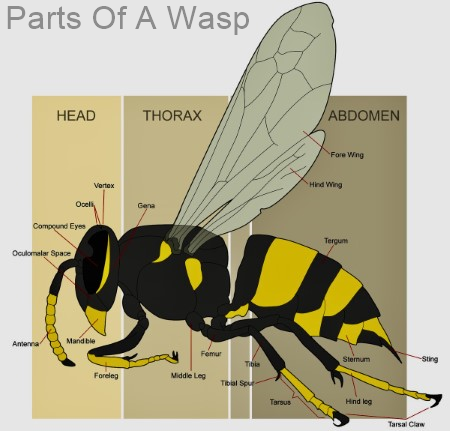
Wasps are narrow-waisted predatory insects of the order Hymenoptera and suborder Apocrita, which are neither bees nor ants. Wasps are a diverse group with an estimate of over a hundred thousand described species worldwide and several thousand species in New York. The most commonly encountered wasps on Long Island, New York, include yellowjackets and paper wasps, including the European paper wasps. These wasps are members of the family Vespidae which are social insects that reside together in a nest with an egg-laying queen and non-reproducing female workers. However, most wasp species are solitary insects, with each adult female living and breeding independently. Solitary wasps found on Long Island include mud dauber wasps, great black wasps, and cicada killer wasps. The nesting habits of solitary wasps are more varied than those of social wasps. All social wasps live in colonies and build their nests using some form of plant fiber as the primary construction material. Wasps play an essential role in horticulture as pollinators of flowers, fruits, nuts, and vegetables and predators of pest insects such as caterpillars, beetles, and whiteflies. Many of the solitary wasps, including the mud dauber wasps and cicada killer wasps, are parasitoidal. Parasitoid wasps lay their eggs on or in the bodies of other arthropods, which are fed upon and eventually killed by the developing wasp larvae. Unlike honey bees, wasps do not store food. Adult solitary wasps primarily feed on nectar, but most of their time is spent foraging for insects to feed their young. Adult social wasps feed mainly upon nectar collected from flowering plants and the juices from fallen fruit. Social wasps will bring carrion, usually in the form of dead insects, back to their nest to feed developing wasp larvae.
Wasps are arthropods with a hard exoskeleton protecting their three main body parts:
Prosoma (the head)
Mesosoma (the thorax and the first abdominal segment)
Metasoma (the second abdominal segment and those segments posterior to it)


Wasps have a narrow waist, referred to as a petiole, where the first and second abdominal segments are constricted.

Wasps have two pairs of membranous wings held together by a row of bristles called the frenulum. The front wings are larger than the rear ones.

Wasps use their stinger to paralyze prey or as a defensive weapon and it is found in the same body part as the ovipositor, the needle-like tube that female wasps use to lay their eggs. Male wasps called drones don't have an ovipositor and therefore can't sting.

Wasps have six jointed legs and two antennae.

Wasps have two large compound eyes, three simple eyes known as ocelli, which are usually arranged in a triangle just anterior to the vertex of the head.

Wasps possess mandibles adapted for biting and cutting and other tubular mouthparts that enable them to drink nectar.


Getting rid of a wasp nest can be both challenging and dangerous. Yellowjackets are deemed to be the most dangerous stinging flying insects in the United States, and there are six species of yellow jackets found on Long Island. Yellowjackets are bold and incredibly aggressive wasps that will repeatedly sting a perceived intruder. Without the proper equipment, training, and pesticides, the removal of a wasp nest from your Long Island residence is a project that is destined to fail. Therefore, you need to contact the wasp nest removal experts at Long Island Pest Control for professional wasp control services. Our Long Island yellow jacket removal exterminators have a vast knowledge of wasp control methods and many years of experience locating wasp nests and choosing the appropriate treatment technique. Because wasp stings are very painful and can produce a potentially lethal anaphylactic reaction in those who are allergic, wasp nests in human-inhabited areas present an imminent danger. Contact the wasp nest removal experts at Long Island Pest Control to get rid of an unwanted wasp nest. Our pest control professionals have backgrounds in entomology and expertise in wasp control strategies. Correctly identifying the type of wasp that is infesting your Nassau County dwelling is key to Long Island wasp removal.